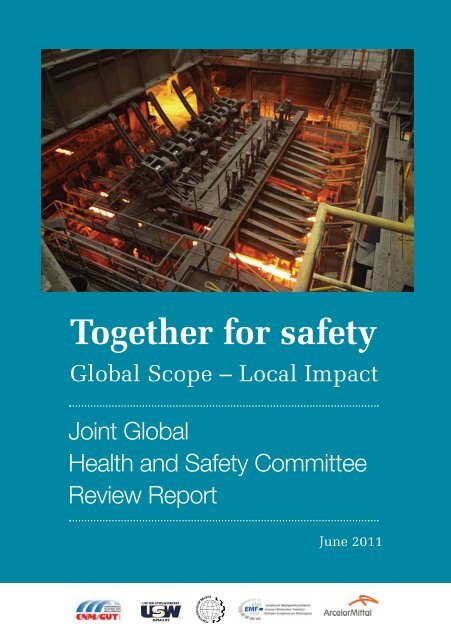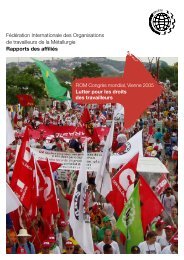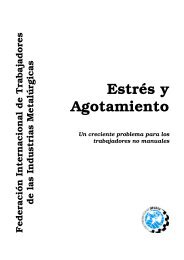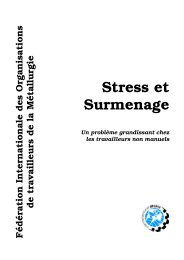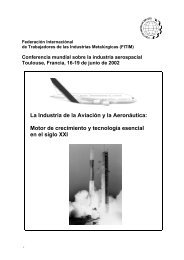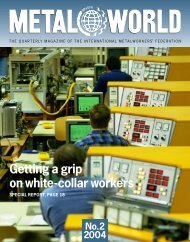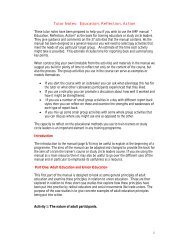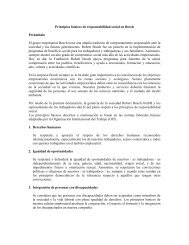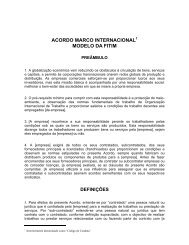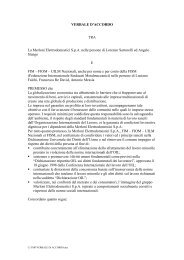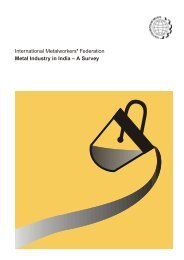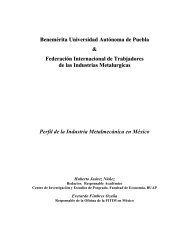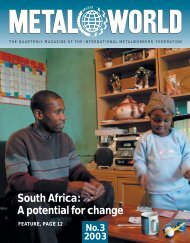Together for safety - Industriall
Together for safety - Industriall
Together for safety - Industriall
Create successful ePaper yourself
Turn your PDF publications into a flip-book with our unique Google optimized e-Paper software.
<strong>Together</strong> <strong>for</strong> <strong>safety</strong><br />
Global Scope – Local Impact<br />
Joint Global<br />
Health and Safety Committee<br />
Review Report<br />
June 2011
| Contents<br />
Table of Contents<br />
Introduction page 3<br />
Executive Summary page 4<br />
Analysis of the challenges<br />
1) Contractors page 6<br />
2) Personal Protective Equipment page 8<br />
3) Violation’s Policy page 9<br />
Overview of the situation in the different countries<br />
& outstanding issues<br />
1) Kazakhstan (September 2008) page 12<br />
2) Brazil – Timóteo (November 2008) and Tubarão (March 2011) page 13<br />
3) Mexico (March 2009) page 14<br />
4) Czech Republic: Ostrava (June 2009) page 15<br />
5) Romania: Galati (September 2009) page 15<br />
6) South Africa: Vanderbijlpark (January 2010) page 16<br />
7) USA: Indiana Harbor and Burns Harbor (April 2010) page 17<br />
8) Argentina: Villa Constitución (March 2011) page 17<br />
9) Ukraine: Kryviy Rih (August 2010) page 18<br />
Special thanks to Michael Briedbach (IG-Metal) <strong>for</strong> providing the images used in the report.<br />
Disclamer<br />
Although a lot of care has been given to describing the actual situation at the time of the visit to the sites, as well<br />
as to any evolution on each of the sites visited since then, further evolution may have occurred and thus the<br />
Review Report is only giving a valid status at time of writing<br />
2 | www.imfmetal.org
Introduction |<br />
Introduction<br />
The intention of this publication is to review the work of the<br />
ArcelorMittal Joint Global Health and Safety Committee<br />
(JGHSC). Also, to provide some analysis of the JGHSC as to<br />
why the number of fatalities in the company remains<br />
unacceptable high and what measures that can be taken to<br />
improve the current situation.<br />
The JGHSC was <strong>for</strong>med as result of an agreement signed<br />
by management and unions on 3rd June 2008. The<br />
agreement set out the terms of reference <strong>for</strong> a JGHSC and<br />
also the minimum requirements <strong>for</strong> local JHSC. Trade union<br />
committee members include 1 participant from International<br />
Metalworkers’ Federation, 4 participants from the European<br />
Metalworkers’ Federation, 3 participants from the United<br />
Steelworkers, 1 participant from Latin America (CNM-CUT),<br />
1 participant from Mining area. From management side 6<br />
members are present, including Corporate Health and<br />
Safety, Employee Relations and Business Unit H&S<br />
representatives.<br />
To date the JGHSC agreement still remains the only one of<br />
its kind in the steel industry.<br />
Prior to signing the agreement the company had faced its<br />
worst year <strong>for</strong> fatalities and both unions and management<br />
identified <strong>safety</strong> as their number one priority. Despite some<br />
differing views amongst unions and management the<br />
committee has been able to put these aside and work in a<br />
very practical and pragmatic way. Over the last two years<br />
77 workers have lost their lives (36 in 2009, 41 in 2010); the<br />
number of fatalities remains unacceptable high <strong>for</strong> both<br />
unions and management alike. Although since signing the<br />
agreement the total number of fatal incidents has come<br />
down by about one third.<br />
The JGHSC agreement was a shared recognition that the<br />
most effective tool in ensuring good health and <strong>safety</strong> in the<br />
workplace is cooperation between trade unions and<br />
management. The spirit of the agreement is that by<br />
identifying common ground between workers, unions and<br />
management on health and <strong>safety</strong> issues it’s possible to<br />
make a positive impact on the number of accidents in the<br />
workplace and to significantly reduce the risk faced by<br />
workers. Following the signing of the agreement the JGHSC<br />
undertook a survey of national unions and management to<br />
check implementation; in 94% of replies a JGHSC had<br />
already been established.<br />
The main functions of the JGHSC has been check, follow-up<br />
and guide the implementation of the local JHSC, as well as<br />
to identify areas <strong>for</strong> improvement in the company and to act<br />
as a facilitator in harmonizing <strong>safety</strong> per<strong>for</strong>mance across the<br />
group. The committee only deals with issues related to<br />
health and <strong>safety</strong> and it does not act as a negotiating<br />
committee on behalf of unions or management; its function<br />
is solely to offer guidance. Since signing the agreement the<br />
JGHSC has visited 9 countries (Mexico, Brazil, Kazakhstan,<br />
Ukraine, Romania, Czech Republic, Argentina, South-Africa,<br />
USA) in order to help them further improve health and <strong>safety</strong><br />
per<strong>for</strong>mance. Visits have included both mining operations<br />
and steel plants, and follow a set <strong>for</strong>mat.<br />
Normally, a plenary meeting is held in the presence of local<br />
unions and management, then a breakout session of the<br />
local union and JGHSC union members resp. local<br />
management and JGHSC management. During the<br />
breakout implementation and the work of the local JHSC is<br />
discussed. Local unions help select which areas of the plant<br />
should be visited especially if there are areas in need of<br />
attention; the areas to visit are then agreed between both<br />
sides of the JGHSC. Following the site visit another plenary<br />
session is held in order <strong>for</strong> local management and unions to<br />
hear the recommendations of the JGHSC and after the visit<br />
an action plan is developed by the site. Following the site<br />
visit, the sites provide an update to the JGHSC each time it<br />
meets and in some cases a follow up visit will be arranged<br />
<strong>for</strong> a (few) member(s) of the JGHSC to check and report<br />
on progress.<br />
A special word of thanks must be given to the members of<br />
the JGHSC who have put a lot of time and ef<strong>for</strong>t not only into<br />
the visits but also in this review and the day to day work that<br />
goes on behind the scenes. Many of the committee<br />
members have experienced fatalities on their own sites or<br />
visited the sites of fatalities and it is never easy to see a<br />
colleague lose his / her live.<br />
The main message from the JGHSC is<br />
“If the job is not safe,<br />
then don’t do it!”<br />
www.imfmetal.org |<br />
3
| Executive Summary<br />
Executive summary<br />
The work of the JGHSC demonstrates that it is meeting<br />
most of the objectives set out <strong>for</strong> it in the Terms of<br />
Reference. The Committee’s work has had a positive impact<br />
on the number of accidents in the workplace, especially<br />
fatalities, and helped to reduce the risk faced by workers.<br />
The JGHSC has also helped to improve communication,<br />
collaboration and coordination between unions and<br />
management, locally as well as globally. These<br />
achievements have occurred through the Committee’s<br />
working method, especially its site visits to Top Priority Sites<br />
where the visits are a benchmark example of joint labourmanagement<br />
activity and through the visits the Committee<br />
acts as a catalyst to local joint <strong>safety</strong> dialogue and follow-on<br />
improvements.<br />
There are a number of areas where the JGHSC believes it is<br />
falling short of mutual expectations, however. The increase<br />
in fatalities in 2010 as compared to 2009 is cause <strong>for</strong><br />
concern. Response to requests <strong>for</strong> training have been<br />
inconsistent. The parties to date have failed to harmonize<br />
their differences on penalties <strong>for</strong> violations of Golden Rules.<br />
Joint dialogue on H&S is not uni<strong>for</strong>mly excellent at every<br />
business unit and work site.<br />
The JGHSC will focus its future ef<strong>for</strong>ts on identifying ways<br />
that local JHSC can become more effective, developing<br />
leading indicators of success, and identifying ways to be<br />
more effective with contractor H&S ef<strong>for</strong>ts. Also continue to<br />
push <strong>for</strong> a joint approach to health and <strong>safety</strong> at local level<br />
which includes management and unions equally.<br />
The parties remain committed to the JGHSC ef<strong>for</strong>t, and see<br />
this Joint Report, and separate management and union<br />
statements, as evidence of robust and principled dialogue<br />
that are hallmarks of building a positive workplace culture.<br />
What went well<br />
The number of fatalities incidents experienced in the Group<br />
has come down by about 30 % in 2009 and 2010 as<br />
compared to 2008. This is a positive development,<br />
especially as it occurred during a time of extraordinary<br />
turmoil in the economy with the worst recession in the<br />
developed world since the 1930’s. A number of actions<br />
contributed to this encouraging result, and the JGHSC<br />
played a principal role, communicating to all of the Group’s<br />
280,000 employees and contractors that effective dialogue<br />
with trade unions was a good way <strong>for</strong>ward to reduce<br />
hazards and increase <strong>safety</strong>.<br />
100<br />
Number of fatalities<br />
100<br />
Number of fatal events<br />
90<br />
90<br />
80<br />
80<br />
70<br />
70<br />
60<br />
60<br />
50<br />
50<br />
40<br />
40<br />
30<br />
30<br />
20<br />
20<br />
0<br />
0<br />
0<br />
2004<br />
2005 2006 2007 2008 2009 2010<br />
0<br />
2004<br />
2005 2006 2007 2008 2009 2010<br />
Steel OP<br />
Steel SP Mines OP Mines SP<br />
Steel OP<br />
Steel SP Mines OP Mines SP<br />
4 | www.imfmetal.org
Executive Summary |<br />
An in<strong>for</strong>mal 2010 survey indicated that local JHSC had been<br />
established in virtually all units of the Group. The JGHSC has<br />
begun to move toward fostering an improvement in how site<br />
committees operate, through examination of minutes kept<br />
by local JHSC when the JGHSC has visited a location. The<br />
JGHSC was especially impressed with the quality of the<br />
participation and effectiveness at the Acindar location in<br />
Argentina, as a potential benchmark of working method and<br />
participation. The JGHSC will further lead in this direction by<br />
surveying the effectiveness of site joint committees and<br />
encouraging follow-on improvements.<br />
The JGHSC site visits to various locations have helped<br />
stimulate improvement. The additional focus brought to bear<br />
on targeted locations has been largely positive, and the local<br />
parties’ observation of how a local JHSC operates has<br />
been a positive leadership initiative <strong>for</strong> those sites with less<br />
developed cultures of cooperation by management and<br />
union groups. The combination of plenary meetings, uniononly<br />
and management-only sessions, joint inspections and<br />
group restitution seems to have been an effective method of<br />
operation.<br />
Typically the local parties agree a follow up plan of action<br />
after joint inspections, and group conference calls are<br />
regularly held between JGHSC and local parties to assess<br />
progress. Positive attitudes on the follow up work has helped<br />
to build stronger <strong>safety</strong> ef<strong>for</strong>ts at the sites and improved<br />
communication.<br />
What has not gone well<br />
Everyone shares a sense of concern that, after good<br />
improvement in reducing fatalities, 2010 saw a small reversal<br />
of trend, fully due to steel business (since Mining showed a<br />
further improvement in 2010 as compared to 2009). We all<br />
hope and expect that this was an aberration, but a<br />
disappointment nevertheless.<br />
Senior management participation in the JGHSC has not<br />
been consistent. This makes it more difficult <strong>for</strong> the JGHSC<br />
to function smoothly and efficiently, and some may view lack<br />
of consistent participation as an indicator that <strong>safety</strong> takes a<br />
lower level of importance. This would be a perception issue<br />
only, as no one doubts individual member commitment.<br />
A perception problem also occurred as an unintended<br />
consequence of the Hamilton Summit – although<br />
management is convinced the conclusions of this summit<br />
will elevate attention to improving <strong>safety</strong>, union members of<br />
the JGHSC felt the ef<strong>for</strong>t did not sufficiently involve local<br />
JHSC in follow on work so far.<br />
those employees—including managers—<strong>for</strong> violations of the<br />
Golden Rules. Readers are directed to separate statements<br />
on this subject in the attachments.<br />
Training is an important tool in identifying hazards and<br />
reducing risk as well as in fostering safe work practices.<br />
Progress has been slow in certain perimeters — like<br />
Kazakhstan — where employee groups and unions sought<br />
JGHSC assistance in improving training in a number of<br />
areas, including training of local union leaders in how to both<br />
lead and to serve effectively in local JHSC activities.<br />
Administration of the JGHSC could be improved. That’s why<br />
calendars are now set <strong>for</strong> the year; while to some may seem<br />
minor, it improves Committee functioning by minimizing<br />
travel expenses and fostering improved communication and<br />
follow up.<br />
The Group’s desire to reduce accidents through publication<br />
of Golden Rules and associated actions, including penalties<br />
<strong>for</strong> violations of same, has not been without controversy.<br />
There is consensus support <strong>for</strong> the Golden Rules<br />
themselves, and in most countries trade union<br />
representatives were involved with preparation and<br />
communication of the Rules. Although there is quite some<br />
common ground, union members of the JGHSC have<br />
reservations about changes in company rules to punish<br />
www.imfmetal.org |<br />
5
| Analysis of the challenges<br />
Analysis of the challenges<br />
1) Contractors<br />
The JGHSC Committee believes that contractor <strong>safety</strong><br />
per<strong>for</strong>mance should be a high priority. Results show that<br />
contractors do not per<strong>for</strong>m to the same level as<br />
ArcelorMittal’s own employees. The experience of the<br />
JGHSC site visits is that poor contractor per<strong>for</strong>mance<br />
undermines <strong>safety</strong> standards and greater attention needs<br />
to be given to the implementation of the existing corporate<br />
guidelines. The local JHSC can play a vital role in achieving<br />
compliance and higher standards by working together on<br />
this issue. Greater attention must be given to the<br />
en<strong>for</strong>cement of ArcelorMittal’s internal standards and<br />
ensuring that all contractor companies comply with them.<br />
35<br />
Number of fatalities – steel<br />
0,14<br />
Fatality frequency rate – steel<br />
3,0<br />
LTI frequency rate – steel<br />
30<br />
contractors<br />
own<br />
0,12<br />
2,5<br />
25<br />
0,10<br />
2,0<br />
20<br />
15<br />
0,08<br />
0,06<br />
1,5<br />
10<br />
0,04<br />
1,0<br />
5<br />
0,02<br />
0,5<br />
0<br />
2009 2010<br />
0,00<br />
2009 2010<br />
0,0<br />
2009 2010<br />
14<br />
Number of fatalities – mining<br />
Fatality frequency rate – mining<br />
0,70<br />
3,0<br />
LTI frequency rate – mining<br />
12<br />
contractors<br />
own<br />
0,60<br />
2,5<br />
10<br />
0,50<br />
2,0<br />
8<br />
6<br />
0,40<br />
0,30<br />
1,5<br />
4<br />
0,20<br />
1,0<br />
2<br />
0,10<br />
0,5<br />
0<br />
2009 2010<br />
0,00<br />
2009 2010<br />
0,0<br />
2009 2010<br />
6 | www.imfmetal.org
Analysis of the challenges |<br />
For example In Mexico in 2008 we saw contractor<br />
management in its worst <strong>for</strong>m:<br />
Managers had no idea how many contractors were on<br />
site at any time, they paid <strong>for</strong> a particular function to be<br />
carried out <strong>for</strong> a certain price with no knowledge of how<br />
many were employed to do the job. The contractors had<br />
their own gate to access and leave the plant with no<br />
check on their coming and going.<br />
The contract price included the provision of PPE which<br />
was in almost all cases not provided, the contractors had<br />
to scavenge PPE from bins when the core workers threw<br />
them away. We witnessed examples of individual cutting<br />
and welding in sandals and shorts with neither gloves<br />
nor masks.<br />
They were allowed to manufacture or adapt their own<br />
tools with no interest in H&S concerns from either their<br />
own management or the ArcelorMittal management.<br />
As far as we could determine injuries were not reported,<br />
the individual hurt was just replaced; this of course<br />
reflects badly on the reported figures <strong>for</strong> accidents etc.<br />
There was also an issue raised by the local union over<br />
freedom of association <strong>for</strong> contractors where the<br />
numbers joining the union was limited to a small<br />
percentage of the total.<br />
To date this was the worst experience of the JGHSC<br />
but similar examples exist. Since 2008 a program of<br />
improvement has been in place in Mexico (see report<br />
below) but the underlying problem of contractor<br />
per<strong>for</strong>mance across sites still exists.<br />
Recommendations:<br />
There are clear corporate guidelines <strong>for</strong> contractors but<br />
training on these does not often include union <strong>safety</strong><br />
representatives or shop floor workers. Training members<br />
of the local JHSC, including union reps would help to<br />
improve the implementation of corporate standards.<br />
“This agreement,<br />
with which we hoped<br />
to set a new benchmark<br />
in the industry, and the Joint<br />
Global Health and Safety<br />
Committee that was created as<br />
a consequence of it, over the 3<br />
years of their existence, have<br />
improved cooperation with Unions<br />
and helped us to make progress<br />
on our Journey to Zero in Health<br />
and Safety, as the evolution of the<br />
results shows. I count on this<br />
committee to further boost<br />
progress in health and <strong>safety</strong> to<br />
reach the challenging objectives<br />
the company has set <strong>for</strong> itself,<br />
since health and <strong>safety</strong> remains<br />
the top priority. Innovation and<br />
not being afraid to make bold<br />
decisions have been at the heart<br />
of our success.”<br />
Mr Mittal,Chairman and<br />
Chief Executive Officer, ArcelorMittal<br />
www.imfmetal.org |<br />
7
| Analysis of the challenges<br />
2) Personal Protective Equipment (PPE)<br />
The experience of the JGHSC has shown mixed results<br />
in both the standard of PPE and also its implementation.<br />
Often the standard complies with the standard set by the<br />
local competent authority, or recognized national body<br />
but not always the highest standard within the company.<br />
Implementation and the use of PPE also vary from site to<br />
site with many examples of situations in which workers or<br />
managers have not complied with internal governance. In<br />
particular the experience of the JGHSC from its site visits<br />
has been that contractors there were less likely to comply<br />
with guidelines and there<strong>for</strong>e that could undermine<br />
standards.<br />
This undermines the credibility of the management’s<br />
<strong>safety</strong> approach.<br />
More attention is being given to standardizing PPE and<br />
rolling out best practice from within the company; more<br />
attention to be given to speeding up this process,<br />
allowing time <strong>for</strong> proper shop floor testing of any change.<br />
This would ensure that a worker from an ArcelorMittal<br />
plant in one country could walk into another plant and<br />
recognize the similar standard.<br />
“Signing this agreement<br />
should act as a signal to<br />
other companies in the industry<br />
that unions are the solution to<br />
health and <strong>safety</strong> concerns, not<br />
the cause. Health and <strong>safety</strong> is the<br />
single most important issue <strong>for</strong><br />
workers. It is satisfying that we<br />
have delivered this approach in the<br />
world’s number 1 steel company”<br />
Leo Gerard, International President<br />
of the United Steelworkers<br />
The best practice in the company should be to involve the<br />
local JHSC in the testing and implementation of suitable<br />
PPE. The input from the local JHSC is important taking<br />
into account that:<br />
1. Proper maintenance and use of PPE, including<br />
appropriate training of the user, are essential <strong>for</strong><br />
providing the protection <strong>for</strong> which it is designed<br />
2. PPE itself may produce uncom<strong>for</strong>table, unhealthy or<br />
unsafe working conditions or additional hazards,<br />
3. PPE can provide a false sense of security, in particular<br />
when it is not properly used or has lost its effectiveness<br />
as a result of improper storage or maintenance<br />
Recommendations:<br />
• Standardization of PPE to the best practice available<br />
• Use the local JHSC as an advisory body on PPE<br />
decisions<br />
8 | www.imfmetal.org
Analysis of the challenges |<br />
3) Safety Rule Violation Policy<br />
Training of people to do their job <strong>safety</strong> is the<br />
starting point.<br />
We believe that workers involvement, in a positive<br />
environment created by committed leaders (union and<br />
management), is the solution to the problem. There is noone<br />
better way to identify the hazards on a job, or come<br />
up with ideas to eliminate or reduce those hazards, than<br />
including the workers doing the job.<br />
The common ground of the JGHSC is that rather than just<br />
blame workers <strong>for</strong> bad or unsafe behaviours such as not<br />
wearing PPE or not following procedures, is that we also<br />
ask the question WHY. The fact is, good occupational<br />
<strong>safety</strong> and health practices are based on the<br />
understanding that all work-related injuries and illnesses<br />
can be prevented. The goal of workplace health and<br />
<strong>safety</strong> ef<strong>for</strong>ts, then is to jointly find and correct all hazards<br />
and to understand and change systems of work.<br />
Supervision and crew members should be actively<br />
working together to eliminate workers exposures to<br />
hazards, provide good PPE, have good procedures and<br />
follow these procedures.<br />
In order to do this we jointly (union-management)<br />
encourage you to report injuries and near misses to local<br />
management. ArcelorMittal will neither establish any<br />
program, policy nor accept any practice that might<br />
discourage employees from reporting accidents, injuries<br />
or illnesses; it could in fact be deadly.<br />
Every worker also has the obligation to follow the rules,<br />
since everyone has a role to play in obtaining good <strong>safety</strong><br />
results, we also agree that discipline may be necessary<br />
in cases of wilful defiance and outright recklessness, in<br />
which employees can endanger themselves and / or<br />
colleagues. As <strong>for</strong>eseen in the policy, sanction will only<br />
be taken after considering all circumstances.<br />
The JGHSC will follow the implementation of Golden<br />
Rules and Safety Violation Policy on an ongoing basis.<br />
www.imfmetal.org |<br />
9
| Analysis of the challenges<br />
Union statement<br />
Although the JGHSC agree on the statement above the<br />
union side also have severe reservations about the<br />
intention behind the Golden Rules and Violations Policy.<br />
In many other companies behaviour based systems have<br />
been tried and tested and failed often to the detriment of<br />
the work<strong>for</strong>ce and <strong>safety</strong>.<br />
Most ArcelorMittal unions and union members of the<br />
JGHSC do not object to the concepts expressed in the<br />
rules themselves. All of them are common sense<br />
measures that should guide any worker in any workplace.<br />
However the unions are concerned about basing<br />
ArcelorMittal’s overall <strong>safety</strong> system on disciplining<br />
workers <strong>for</strong> rules violations. The unions believe this<br />
violations policy is based on a flawed analysis of past<br />
accidents. We believe that there is a danger that it will<br />
impede <strong>safety</strong> by driving down the reporting of minor<br />
accidents and near misses, and by creating a lazy <strong>safety</strong><br />
management culture. The unions do not believe that<br />
ArcelorMittal can discipline its way to a safer workplace<br />
nor should it try.<br />
The concern is that the violations policy as it is currently<br />
written allows discipline in the case of honest mistakes<br />
or momentary lapses caused by fatigue or distraction.<br />
The unions recognize that rigorous hazard identification,<br />
workplace <strong>safety</strong> audits, and root cause incident<br />
investigation are time consuming and hard. Punishing<br />
workers <strong>for</strong> alleged rules violations is easy. Given a<br />
choice, the suspicion is that many managers may choose<br />
the easy way. Sadly the company’s violations policy<br />
empowers them to do this and examples already exist.<br />
The possible harm that results from a policy focused on<br />
discipline is illustrated by an incident at Indiana Harbour.<br />
On July 4, 2010, three workers voluntarily reported a<br />
near miss accident, and suggested that steps be taken<br />
to prevent a reoccurrence. All three were blamed <strong>for</strong> the<br />
incident and given 5 day suspensions. The discipline<br />
was later rescinded, but the damage has been done, and<br />
workers are reluctant to report minor accidents and nearmisses<br />
if they think they will be blamed. This is just one<br />
example but if replicated across the whole company<br />
then sadly the potential <strong>for</strong> fatal accidents will increase.<br />
The union side recommend that the JGHSC closely<br />
monitors and is in<strong>for</strong>med of any cases in which workers<br />
or management are dismissed due to Golden Rules<br />
and Violations policy in order to monitor the situation<br />
and implementation.<br />
“We have worked hard to<br />
ensure the implementation<br />
of this agreement, during the<br />
visits of the JGHSC we have found<br />
examples of best practice <strong>for</strong> the<br />
industry but also areas to improve”<br />
Luis Colunga,<br />
European Metalworkers Federation,<br />
coordinator ArcelorMittal EWC.<br />
10 | www.imfmetal.org
Analysis of the challenges |<br />
Management statement<br />
The area of disagreement on the “Violations Policy” is<br />
relatively small. Consistent with scientific learning, we<br />
all accept that a safe workplace is the result of the totality<br />
of behaviour by all participants in the system, and that<br />
potential adverse consequences can influence the<br />
behaviour of those participants. Our trade union<br />
colleagues acknowledge that there is a set of unsafe<br />
behaviours that could warrant adverse workplace<br />
consequences <strong>for</strong> employees, supervisors and<br />
contractors—known as discipline—those being gross<br />
negligence or reckless disregard. Management believes<br />
this is too narrow a standard, however, and discipline<br />
may be appropriate <strong>for</strong> additional unsafe behaviours<br />
depending upon the circumstances,<br />
ArcelorMittal is certainly not ‘basing ArcelorMittal’s overall<br />
<strong>safety</strong> system on disciplining workers <strong>for</strong> rules violations’.<br />
The Group has defined from the start and is continuously<br />
working towards all principles embedded in the<br />
ArcelorMittal Health and Safety Policy.<br />
There is no disagreement that the main responsibility <strong>for</strong><br />
a safe workplace lies with management. The first intent of<br />
the policy is to gain compliance with the rules to promote<br />
safer workplaces. Un<strong>for</strong>tunately our experiences of severe<br />
injuries teaches us that often times the potential <strong>for</strong> an<br />
accident alone isn’t sufficient <strong>for</strong> some people to follow<br />
the rules and do what is right. As a consequence, as in<br />
any system (as it is in public life) people who would really<br />
not want to abide by the rules do face consequences.<br />
Consequences, as described in the policy, are<br />
proportional to the deviation. The policy clearly states<br />
the different steps and takes into account the situation<br />
in which the deviation is detected.<br />
We do not agree with the union comment about<br />
“punishing workers <strong>for</strong> alleged rules violations being<br />
easy”. The majority of supervisors choose not to<br />
discipline, but rather work with their crews to find better<br />
and safer ways to do the work. They work with their crews<br />
day in and day out and many are friends having worked<br />
together <strong>for</strong> years. And secondly, if sanction would be<br />
considered appropriate, this will only be applied after<br />
investigation, taking into account the substitution<br />
principle, and giving the person the chance to defend<br />
him/herself, a decision will be taken.<br />
There is no evidence that the potential <strong>for</strong> discipline<br />
discourages reporting of hazards. If that were the case,<br />
there would be no history of incident reporting at all<br />
because discipline <strong>for</strong> rule violation has been part of the<br />
employee relations system <strong>for</strong> decades; the GR violations<br />
policy merely highlights those instances where experience<br />
teaches us serious injury or death could result.<br />
ArcelorMittal wants all incidents (the consequence being<br />
mild or severe), near hits, unsafe situations and unsafe<br />
acts to be reported, since reporting is the basis <strong>for</strong><br />
improvement be<strong>for</strong>e repetition that may lead to (more<br />
harm). In this respect a rigorous follow-up of the shape<br />
of the <strong>safety</strong> pyramid has been started as well as of its<br />
evolution over time and a motivation campaign on<br />
reporting all starts in June 2011.<br />
All levels of management have made it clear in more<br />
than one occasion that a job that can not be done safely,<br />
it must not be done. This is also part of the principle that<br />
everyone has a role to play in <strong>safety</strong>.<br />
There<strong>for</strong>e, management intends to continue the process<br />
with trade unions of jointly identifying hazards and<br />
eliminating them. Management firmly agrees with the<br />
union that the best approach here is a joint one. Since<br />
the inception of the GR policy, this has been going on in<br />
greater measure. This has been the greatest benefit to the<br />
implementation of the policy. Hazards are being identified<br />
and corrected so persons won’t be exposed to hazards<br />
or discipline. The result has been greater awareness,<br />
many improvements in engineering controls, and better<br />
adherence to work practices. Correcting hazards<br />
associated with these rules has been the overriding<br />
concern and will be so going <strong>for</strong>ward.<br />
ArcelorMittal is deeply committed to health and <strong>safety</strong><br />
and finding ways to eliminate hazards including requiring<br />
adherence to life threatening standards. Discipline has<br />
been and will continue to be administered in a fair and<br />
equitable manner as it relates to this policy and dictated<br />
by circumstances. The critical work of involving the<br />
work<strong>for</strong>ce to identify and eliminate hazardous situations<br />
will relentlessly continue.<br />
This system is not different from what exists in other<br />
companies. In fact in other companies the rules are<br />
sometimes even more severe<br />
www.imfmetal.org |<br />
11
| Overview<br />
Overview of the situation in<br />
the different countries<br />
& outstanding issues<br />
1) Kazakhstan (September 2008)<br />
The first meeting of the ArcelorMittal Joint Global Health<br />
and Safety Committee took place in Kazakhstan between<br />
September 30th – Oct 1st, 2008. The committee visited<br />
both the steel plant in Temirtau and the mines at Kostenko<br />
and Abayskaya where 31 miners had been killed in<br />
January that year.<br />
Plant and mine visits were conducted in both the Steel<br />
and Coal Divisions and meetings held with both<br />
management and trade union representatives.<br />
Temirtau<br />
A number of issues were raised during Union and<br />
Management meetings as well as during the visit to<br />
the steel plant and mines including the following:<br />
• PPE needed improving<br />
• Occupation health prevention program was required<br />
• There was a need to provide training to site JHSC<br />
representatives<br />
• There was a need to improve the contractor selection<br />
and H&S auditing process.<br />
• Washrooms, showers and eating areas all needed<br />
much improvement<br />
• General site housekeeping needed working on<br />
It was also reported that employees felt frightened to<br />
stop machinery or report hazards to local management<br />
due to production pressures or fear of being disciplined.<br />
This issue was taken up immediately by both the unions<br />
and management of the global committee and clear<br />
instructions given that health and <strong>safety</strong> is the number<br />
priority <strong>for</strong> the company in all of its operations<br />
The two main issues raised wereas the arrival and<br />
installation of the new equipment, also production<br />
pressures and a fear of the workers to raise health<br />
and <strong>safety</strong> issues with local management. Both of<br />
these issues were addressed directly with senior<br />
local management.<br />
The JGH&SC decided to send a small delegation to<br />
Kazakhstan to determine what changes took place and<br />
what recommendations had been implemented since<br />
the initial visit. This took place in April 2009. An 18 month<br />
programme to complete major investment and implement<br />
the necessary standards had been embarked upon.<br />
The consensus view is that definite improvements had<br />
been made since the visit of the JGH&SC in September<br />
2008, but that a long road lays ahead. The management<br />
and unions agreed that the following improvements<br />
had occurred:<br />
• A positive change in worker and management attitude<br />
towards <strong>safety</strong><br />
• Employee involvement in H&S decision-making<br />
• Improvement of PPE quality<br />
• Health monitoring and prevention<br />
• Improved washroom, showers and eating areas<br />
• Union delivered training <strong>for</strong> representatives<br />
Mining Division<br />
Investment had been approved and various projects are<br />
being implemented. Some new equipment had been<br />
installed to date. Additional installation was subject to<br />
manufacturer delivery schedules over the next 18 months<br />
Kostenko and Abayskaya Mines<br />
The need <strong>for</strong> investment of a long period is clear,<br />
with walkways, lighting, communication, gas removal<br />
and detection systems are all in need of improvement.<br />
Improvements will take place once the new equipment<br />
starts to arrive and is installed.<br />
12 | www.imfmetal.org
Overview |<br />
2) Brazil: Timóteo (November 2008) and Tubarão (March 2011)<br />
Since the visit of the JGHSC to Timoteo, many of the<br />
practical issues raised have been followed up. However<br />
the underlying issue of relations between management<br />
and unions remains an ongoing concern. In principle<br />
the Brazilian management complies with the global<br />
agreement by having local CIPA committees, in practice<br />
the spirit of building cooperation between local unions<br />
and management is not effective.<br />
Although Timoteo has taken some steps towards better<br />
participation from both sides (union and management)<br />
there is still some way to go. Building transparency by<br />
giving access to in<strong>for</strong>mation, reports etc is an important<br />
first step, building mutual respect is another. The visit<br />
of the JGHSC has helped by identifying in<strong>for</strong>mation<br />
exchange as one of its recommendations; this has<br />
started to happen but still needs to be improved.<br />
One positive action from the visit has been the creation<br />
of a local joint union and management <strong>safety</strong> committee.<br />
This innovation underlined the importance of the JGHSC<br />
and should have helped to address the weakness<br />
between union and managements relationship. Although<br />
this committee has met, meetings appear to be infrequent<br />
and both parties question each other’s commitment.<br />
Since the visit of the JGHSC, two fatalities have occurred<br />
on site and to the JGHSC it remains unclear if both parties<br />
have really cooperated with each other during the<br />
investigation process.<br />
Many of the recommendations made by the JGHSC<br />
about improving union management relations also<br />
reoccur in the visit to Tubarão, Brazil. And most likely<br />
exists in the some other sites in Brazil. Although<br />
Employee Relations is not within the scope of the JGHSC,<br />
better cooperation between both parties would certainly<br />
strengthen the health and <strong>safety</strong> approach. This issue can<br />
only be dealt with at the country level, but best practice<br />
examples elsewhere in the company can also assist.<br />
In Tubarao the JGHSC got to see first- hand the problems<br />
of cooperation between management and union, during<br />
the plenary session not one representative from the local<br />
union was present. However following an intervention<br />
from the JGHSC the local unions were later invited to<br />
attend. The site itself had good standards and it was<br />
clear that a lot of attention was given to housekeeping<br />
issues. Contractor <strong>safety</strong> standards were not as good as<br />
ArcelorMittal own employees and this is a priority area <strong>for</strong><br />
the site. Building an inclusive approach between union<br />
and management on <strong>safety</strong> issues could help to build<br />
understanding and there<strong>for</strong>e cooperation.<br />
However, the model of creating a truly local JHSC is<br />
a benchmark in the Brazilian context and if it proves<br />
successful in the longterm could lead the way. Unions,<br />
management and CIPA should all be working towards<br />
the same goal 0 fatalities, building greater transparency<br />
will be an essential part of achieving that aim.<br />
In almost every meeting on the JGHSC to date the<br />
challenge of the situation in Brazil has been raised<br />
especially given the high number of recent fatalities that<br />
have occurred. The recommendation of the Joint Chair’s<br />
of the JGHSC is that the ongoing situation be dealt<br />
with at country level and both corporate<br />
management and the International<br />
Metalworkers’ Federation are willing<br />
to act as facilitators in trying to<br />
develop a strategy which local<br />
unions and management can<br />
agree too.<br />
“The most positive fact of<br />
the visit in Timóteo was the<br />
creation of a local joint committee.<br />
This innovation unveiled the<br />
importance of the JGHSC visit and<br />
helped on what the AM national<br />
workers network points out as the<br />
worst difficulty <strong>for</strong> the unions: the<br />
dialog with the management about<br />
health and security”<br />
Jose Wagner CNM-CUT<br />
www.imfmetal.org |<br />
13
| Overview<br />
3) Mexico (March 2009)<br />
México revisit follow-up<br />
The first visit of Tom Hargrove to Lazaro Cardenas was<br />
April 2007, prior to our Joint Global Health and Safety<br />
Agreement. Steelworkers and Los Mineros have had<br />
a relationship <strong>for</strong> many years.<br />
On our JGHSC visit in March 2009, we found many<br />
issues in the plant, and around the plant. Contractors,<br />
lack of fall protection, lack of equipment, lack of training.<br />
Also, no knowledge of how many contractors was in<br />
the plant at any given time. Homemade tools are used<br />
throughout the plant. There was a lack of concern<br />
about wearing PPE, or absence of PPE. We found<br />
stairways in bad disrepair that needed to be condemned.<br />
Electrical fixtures and connections were haphazard, to<br />
say the least.<br />
On the return visit in 2009, we found many of the issues<br />
still unresolved. The participants took pictures of those<br />
situations and had discussions with the Mineros (local<br />
union) about the <strong>safety</strong> issues. They <strong>for</strong>warded the<br />
pictures and issues raised by the JHSC to Frank Haers,<br />
and the JGHSC.<br />
Mario Garcia, delegate to the National Committee of the<br />
Mineros, visited the Indiana Harbor works in 2009. He<br />
also toured the plant and saw all of the work and training<br />
our advocates and <strong>safety</strong> people do. This was a very<br />
good experience <strong>for</strong> Mario.<br />
The next follow-up visit to Lazaro Cardenas was April<br />
2010. Mario Garcia and the Safety Committee <strong>for</strong> the<br />
Mineros attended this meeting, along with the new<br />
Plant Manager, Bill Chisholm, and José Fernandez at<br />
the company's office.<br />
In 2009 all contractors’ workers received a Safety Training<br />
Course prior to coming to work<br />
Consolidate Health and Safety Contractors Management<br />
System<br />
• Develop a contractor certification System<br />
• Contractor Training;<br />
All contractors have a <strong>safety</strong> induction prior to work,<br />
and undergo refresher training<br />
• Contractor Audits;<br />
Conduct audits of contractor's per<strong>for</strong>mance to<br />
evaluate compliance with the <strong>safety</strong> plan<br />
Housekeeping is part of the audit and evaluation<br />
requirements<br />
Progress is really being made. The union and company<br />
are working together <strong>for</strong> the <strong>safety</strong> of all the workers.<br />
Update April 18th 2011<br />
The latest visit found that progress has continued and the<br />
plant is a lot better organized and cleaner, An immediately<br />
noticeable improvement was a new cafeteria across from<br />
the Coke Plant with hot food. The cafeteria was very clean<br />
with new tables and a wash up area outside. The return<br />
visit to the Electric Arc Furnace was delayed by<br />
management and the suspicion is that during this delay<br />
handrails were painted and new fire hoses installed. The<br />
paint on the handrails was wet and the hoses completely<br />
white also almost all of the workers had new respirators.<br />
One concern was the lack of flame retardant clothing<br />
and very little use of sliver coats, these concerns were<br />
communicated to local management.<br />
Overall each revisit has shown significant progress and<br />
both management and the local union can take credit<br />
<strong>for</strong> that.<br />
The issues discussed were:<br />
• Working with the Union<br />
• Monthly meetings with Union Safety Representatives<br />
• Monthly Joint Safety Inspections<br />
• Assess the local JHSC per<strong>for</strong>mance in the<br />
Health and Safety Steering Committee Meetings<br />
• Accidents and significant near misses investigations<br />
• Response to problems raised by Employees<br />
• Identified needs of training and close the gaps<br />
• Training <strong>for</strong> Union Leaders, Course Safety Tools<br />
of the Safety Management System<br />
• Improved communications<br />
• Working with Contractors<br />
14 | www.imfmetal.org
Overview |<br />
4) Czech Republic: Ostrava (June 2009)<br />
Ostrava is a good example <strong>for</strong> the successful activities<br />
of the Global Join Committee.<br />
Our first visit in Ostrava shows a lot of critical points.<br />
We saw elevators out of function. We saw per<strong>for</strong>ated<br />
roofs, unacceptable washrooms, showers and eating<br />
areas in some places but there are a lot of very clean<br />
and uncluttered areas. But never the less we announced<br />
a lot of improvement points.<br />
A very active Join Health and Safety Committee exists.<br />
We saw that the Trade union is strongly involved in the<br />
<strong>safety</strong> activities.<br />
The site announced that the visit got a lot of value<br />
<strong>for</strong> them :<br />
• Rein<strong>for</strong>cement of communication on H&S agenda<br />
• Reiterated involvement of TU into the H&S process<br />
• External evaluation & identification of the gaps and<br />
benchmarking of the practices in place<br />
• Focus on housekeeping practices and implementation<br />
of 5S method<br />
• Stopped cost saving measures that were jeopardizing<br />
<strong>safety</strong><br />
• Focus not only on Safety issues but also on Health<br />
& Hygiene<br />
When we made the follow up visit with Ludek Lucan,<br />
Hendrik Botha and Michael Breidbach, we saw all points<br />
we announced are in progress or done already.<br />
Washrooms, showers and eating areas were very well<br />
revamped and a system is in place to continuously<br />
monitor and address new priorities as identified. The<br />
most critical points, especially the walkways stairs and<br />
ladders were brought in a safe state. Also improvements<br />
were made in lighting, operating elevators, renovated<br />
roofs, good housekeeping. We are very glad to see<br />
this success.<br />
Ostrava is also implementing the Fatality Prevention<br />
Standards and progress is systematically under Local<br />
JHSC review.<br />
5) Romania: Galati (September 2009)<br />
The JGHSC visited Galati in Sept 2009. During the<br />
journey to the steel plant the JGHSC got to see the<br />
difficulties facing the plant. Transportation on public<br />
roads to the plant was difficult due to poor infrastructure<br />
and neglect due to a lack of investment over a long<br />
period of time. This gave the JGHSC an insight into<br />
the challenges facing the company, as ArcelorMittal<br />
had already made major investments into the plant but<br />
would need to continue to significantly raise standards.<br />
The JGHSC identified a number of areas <strong>for</strong> improvement<br />
during the visit and these included working towards closer<br />
cooperation between unions and management,<br />
improving how the local JHSC functioned. Working<br />
together to reduce the time to solve <strong>safety</strong> issues. Also to<br />
provide joint <strong>safety</strong> training <strong>for</strong> management and unions.<br />
as; JHSC meetings now take place on a monthly basis,<br />
Joint training (60 participants) has taken place. There<br />
are also many other recommendations that have been<br />
implemented.<br />
Achieving the highest <strong>safety</strong> standards remains a<br />
challenge and will take a dedicated ef<strong>for</strong>t over a long<br />
period of time given the lack of investment during its<br />
public ownership. The process has started and the<br />
JGHSC will continue to assist when needed.<br />
Recommendation:<br />
• A return visit should be carried out.<br />
The JGHSC has not yet made a follow-up visit but the<br />
local union leadership plays an active role in the European<br />
Works Council and regularly meets with members of the<br />
JGHSC. Also a regular update is provided to the JGHSC.<br />
Progress has been made and a lot of the original<br />
recommendations have already been implemented such<br />
www.imfmetal.org |<br />
15
| Overview<br />
6) South Africa: Vanderbijlpark (January 2010)<br />
The JGHSC visited the Vanderbijlbark Steel Plant In<br />
Jan 2010. The visit to the site showed that high levels of<br />
cleanliness existed, that direct employees used PPE and<br />
also some areas that capital expenditure would improve<br />
conditions such as the coke batteries.<br />
Areas that needed improvement included developing<br />
greater cooperation between local unions and<br />
management to improve transparency and<br />
communication. The site also had a high level of<br />
contractors (40 per cent) and greater attention needed<br />
to be given to ensure compliance with <strong>safety</strong> rules.<br />
In one example the JGHSC during the site visit discovered<br />
a team of contractors and supervisor working without<br />
PPE.<br />
The local union also highlighted an example in which the<br />
disciplinary process had been unfairly applied, however<br />
this was addressed afterwards.<br />
“This review<br />
demonstrates our<br />
commitment to improve<br />
health and <strong>safety</strong> in ArcelorMittal.<br />
The Joint Global Health and Safety<br />
Committee has carried out a lot<br />
of good work, but achieving zero<br />
fatalities must remain our<br />
highest priority”<br />
Jyrki Raina General Secretary,<br />
International Metalworkers Federation.<br />
Since the visit of the JGHSC committee a number of<br />
improvements took place. Such as an invitation to the<br />
local unions to attend national level meetings on <strong>safety</strong>.<br />
However it appears that contractor management<br />
continues to be an ongoing problem from management.<br />
In addition there is still an ongoing discussion about the<br />
provision <strong>for</strong> full time <strong>safety</strong> representatives. Access to<br />
training <strong>for</strong> union representatives is also an area which<br />
could be improved on.<br />
Just prior to the visit of the JGHSC a multiple fatality<br />
occurred at the Newcastle plant and a small delegation<br />
visited to see what lessons could be learnt to prevent a<br />
similar occurrence elsewhere. Since the visit it has also<br />
been brought to the attention of the JGHSC that there are<br />
concerns related to the random alcohol testing practices.<br />
The JGHSC is in the process of review this claim.<br />
Recommendations:<br />
• A return visit of a smaller team to review progress<br />
• Investigation into the question of random alcohol<br />
testing practices<br />
• Joint training of union and management into<br />
corporate standards on the use of contractors.<br />
16 | www.imfmetal.org
Overview |<br />
7) USA: Indiana Harbor and Burns Harbor (April 2010)<br />
Joint Global Health and Safety Committee visit to Indiana<br />
Harbor April 2010<br />
Indiana Harbor was on the Top Priority Sites list. A lot of<br />
attention was paid by the committee to the July 2009<br />
fatality of Angela Smith in the 80” hot strip slab yard. An<br />
enormous amount of work has already been done to<br />
prevent this from happening again.<br />
Number 2 Steel Plant was the site of one of the committee<br />
visits. A lot of work was going on because of a downturn.<br />
We saw no life-threatening issues. Housekeeping has<br />
improved, but still has a long way to go.<br />
Indiana Harbor West 84 inch mill was also a site of the<br />
committee visit. Numerous issues were raised, but, overall<br />
the visit was very good. Housekeeping remains to be an<br />
issue, not only at the 84 inch, but throughout the plant.<br />
One of the major issues on both East and West side are<br />
the locker room facilities, the toilets not being cleaned<br />
and maintained on a regular basis. An issue with the<br />
ambulance situation on the West side was brought up<br />
by the West side committee. The situation has been<br />
corrected.<br />
There were many comments on the lack of continuity<br />
in the companies Safety Department. We have had a<br />
number of turnovers of Safety Professionals, and also a<br />
Safety Manager. A new Manager was hired in July 2010<br />
and the operation seems to be stabilizing. More work<br />
needs to be done on joint cooperation. The site is working<br />
towards that goal. Communications have improved, and<br />
many activities are in progress working together on key<br />
issues such as lockout, confined space, rail <strong>safety</strong>, arc<br />
flash prevention, incident investigations and hazard<br />
recognition.<br />
Part of the visit was the JGHSC attendance at the<br />
Union Workers Memorial Day Remembrance. This day<br />
is celebrated around the world in honour of those who<br />
have lost their lives on the job. The ceremony is held at<br />
USW Local 1010 Union Hall. The names of all the workers<br />
who have lost their lives on the job at the Indiana Harbor<br />
East site since 1903 are engraved in granite on the wall.<br />
There are 389 names on that wall. Our goal is to never<br />
add another name.<br />
The committee also attended ArcelorMittal Health and<br />
Safety Day activities at Indiana Harbor, Burns Harbor<br />
and Riverdale.<br />
8) Argentina: Villa Constitución (March 2011)<br />
Two years after establishing a local JHSC, ASIMRA and<br />
UOM have established an excellent joint approach to<br />
health and <strong>safety</strong> with ArcelorMittal management at the<br />
Acindar Steel Plant in Argentina, setting a benchmark<br />
<strong>for</strong> other facilities in Latin America.<br />
The ArcelorMittal Joint Global Health and Safety<br />
Committee (JGHSC) met on March 1 to 3 at the Acindar<br />
Steel Plant. The plant produces 90 per cent of Argentina's<br />
long product consumption and has 2675 direct<br />
employees. There are two unions present ASIMRA and<br />
UOM and between them the union density is 85 per cent<br />
of the work<strong>for</strong>ce. The purpose of the visit was to see how<br />
the local joint health and <strong>safety</strong> committee functions and<br />
also to see <strong>safety</strong> standards during a site visit.<br />
The impression of the JGHSC was that the both unions<br />
and management had taken the commitment to health<br />
and <strong>safety</strong> issues very seriously and that a good dialogue<br />
existed with issues being raised and dealt with by the<br />
local JHSC.<br />
Local union representatives explained that in the two<br />
years that the committee has existed they have been<br />
able to build mutual respect with management and a<br />
joint approach to <strong>safety</strong>. The local unions took pride in<br />
the fact that shortly after the local JHSC was <strong>for</strong>med in<br />
ArcelorMittal Acindar the Sante Fe state government<br />
also passed legislation <strong>for</strong> other companies to follow suit.<br />
During the site visit it was clear that the standard was<br />
high but that some capital expenditure was needed in<br />
particular in the steel plant. This investment would help<br />
tackle pollution in the plant and also build on the good<br />
work already carried out. Another area <strong>for</strong> improvement<br />
included the length of time union representatives can<br />
serve on the local JGHSC, currently each representative<br />
has a one year term.<br />
www.imfmetal.org |<br />
17
| Overview<br />
9) Ukraine: Kryviy Rih (August 2010)<br />
The JGHSC visited Kryviy Rih in August 2010, sadly<br />
during the visit a worker suffered a fatal accident.<br />
The <strong>safety</strong> conditions in the plant were found to be<br />
unsatisfactory and, despite ongoing improvements<br />
prior to the visit, a major overhall of <strong>safety</strong> standards<br />
was still needed.<br />
and constructed in all structural subdivisions of<br />
the enterprise, including personal transport of<br />
enterprise employees. Permits to enter the<br />
premises of the enterprise are issued<br />
according to availability of space at the<br />
parking places of structural subdivisions.<br />
Major investments have taken place in the plant in order<br />
to improve working conditions, such as investments in<br />
changing facilities, locker rooms. However items such as<br />
PPE (which can be governed by local legislation) still fall<br />
well below the average standard in the company despite<br />
the fact it complies with national law.<br />
Item 1.5,<br />
Both OP and SP of the enterprise are<br />
<strong>for</strong>bidden to work at height without using<br />
of strapped <strong>safety</strong> harnesses. Managers<br />
and specialists of the enterprise execute<br />
continuous control <strong>for</strong> operating of contractors<br />
at height using strapped <strong>safety</strong> harness.<br />
The JGHSC and local union and management leadership<br />
identified 18 inititial actions <strong>for</strong> improvement.<br />
These actions included a wide range of issues some of<br />
which are contained within the companies Golden Rules.<br />
Of the 18 actions, seven are still pending implementation<br />
(at time of writing) and 2 have been partially implemented.<br />
In order to build the capacity of the local JHSC the<br />
JGHSC has also proposed some union to union training<br />
on auditing, risk assessment and hazard prevention.<br />
This training should take place in 2011.<br />
The seven action points that are still outstanding<br />
(as of April 2011) include:<br />
Item 1.3,<br />
Item 1.4,<br />
use of cell phones by vehicle drivers whilst<br />
driving on the enterprise is <strong>for</strong>bidden<br />
Movement of vehicles inside the factory area<br />
must now be with lights on. Special places <strong>for</strong><br />
parking of automobile transport were designed<br />
Item 1.7,<br />
on eliminating negligence in storing and<br />
operating removable hauling devices; work on<br />
equipping of stands <strong>for</strong> keeping of removable<br />
hoisting devices is being carryied out at the<br />
enterprise.<br />
Item 1.11, on marking pointers (boundaries) of safe<br />
paths in workshops : special oriented<br />
inspections <strong>for</strong> existing of safe travel routes in<br />
the territory of shops are annually carried out<br />
in structural subdivisions of the enterprise.<br />
The corresponding actions are initiated if the<br />
violations are identified.<br />
Item 1.13, on timely and regular cleaning and disinfection<br />
of areas used by personnel. Cleaning and<br />
disinfection of ablutions and public spaces at<br />
the enterprise is executing based on<br />
agreement with contractors. Continuous<br />
control <strong>for</strong> condition of ablutions with regard<br />
to sanitary norms requirements is executed.<br />
18 | www.imfmetal.org
Overview |<br />
A follow up visit will take place to see what improvements<br />
have taken place and also what additional support can be<br />
given in order to continue to improve conditions.<br />
The following items of the Order have not been<br />
implemented:<br />
Item 1.1, Providing of employees with required PPE<br />
and control <strong>for</strong> their use is the duty of each<br />
manager of the enterprise. Up-to-date PPE<br />
are purchased. Currently the commercial<br />
proposals are under examination.<br />
Item 1.6, on elimination of negligence in cable laying<br />
and inscribing functional legends and signs<br />
on electric equipment. Special oriented<br />
inspections of electrical equipment, laying of<br />
cable products, availability of functional labels<br />
and electrical <strong>safety</strong> signs on electrical<br />
equipment in accordance with requirements<br />
of Rules. In progress.<br />
Item 1.8, on organizing and providing free and safe<br />
movement of the personnel in the working<br />
areas. Special oriented inspections of technical<br />
conditions of floorings, plat<strong>for</strong>ms, coverings of<br />
production facilities and constructions <strong>for</strong> safe<br />
and free moving of personnel were carried out<br />
at the enterprise. In progress.<br />
Item 1.10, on lighting the personnel movement paths.<br />
Special monitoring of lighting at the working<br />
places and in the areas of employees’<br />
movement is executed at the enterprise by<br />
Research Working Conditions Laboratory.<br />
Problem areas are tackled. In progress.<br />
www.imfmetal.org |<br />
19
If you would like more in<strong>for</strong>mation<br />
about the JGHSC please contact:<br />
Rob Johnston<br />
Executive Director<br />
Industrial and TNC Policies<br />
International Metalworkers’ Federation<br />
rjohnston@imfmetal.org,<br />
www.imfmetal.org<br />
Frank Haers<br />
VP, Head Corporate Health and Safety<br />
ArcelorMittal<br />
Frank.haers@arcelormittal.com<br />
www.arcelormittal.com


